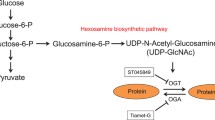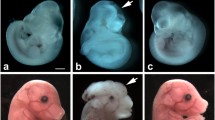Abstract
Maternal diabetes-induced neural tube defects (NTDs) are associated with increased programmed cell death (apoptosis) in the neuroepithelium, which is related to intracellular nitrosative stress. To alleviate nitrosative stress, diabetic pregnant mice were fed via gavage an inhibitor of nitric oxide (NO) synthase (NOS) 2, L-N6-(1-iminoethyl)-lysine (L-NIL; 80 mg/kg), once a day from embryonic (E) day 7.5 to 9.5 during early stages of neurulation. The treatment significantly reduced NTD rate in the embryos, compared with that in vehicle (normal saline)-treated diabetic group. In addition to alleviation of nitrosative stress, endoplasmic reticulum (ER) stress was also ameliorated, assessed by quantification of associated factors. Apoptosis was reduced, indicated by caspase 8 activation. These results show that nitrosative stress is important in diabetes-induced NTDs via exacerbating ER stress, leading to increased apoptosis. Oral treatment with NOS-2 inhibitor alleviates nitrosative and ER stress, decreases apoptosis, and reduces NTDs in the embryos, providing information for further interventional studies to reduce diabetes-associated birth defects.
Similar content being viewed by others
References
Zhao Z, Reece EA. Experimental mechanisms of diabetic embryopathy and strategies for developing therapeutic interventions. J Soc Gynecol Investig. 2005;12(8):549–557.
Loeken MR. Challenges in understanding diabetic embryopathy. Diabetes. 2008;57(12):3187–3188.
Eriksson UJ, Borg LA, Cederberg J, et al. Pathogenesis of diabetes-induced congenital malformations. Ups J Med Sci. 2000;105(2):53–84.
Correa A, Gilboa SM, Besser LM, et al. Diabetes mellitus and birth defects. Am J Obstet Gynecol. 2008;199(3):237. el–e9.
Mills JL. Malformations in infants of diabetic mothers. Teratology. 1982;25(3):385–394.
Sadler TW. Embryology of neural tube development. Am J Med Genet. 2005;135C(l):2–8.
Wallingford JB. Neural tube closure and neural tube defects: studies in animal models reveal known knowns and known unknowns. Am J Med Genet. 2005;135C(l):59–68.
Chappell JH Jr, Wang XD, Loeken MR. Diabetes and apopto-sis: neural crest cells and neural tube. Apoptosis. 2009;14(12): 1472–1483.
Zhao Z, Yang P, Eckert RL, Reece EA. Caspase-8: a key role in the pathogenesis of diabetic embryopathy. Birth Defects Res B Dev Reprod Toxicol. 2009;86(l):72–77.
Gareskog M, Cederberg J, Eriksson UJ, Wentzel P. Maternal diabetes in vivo and high glucose concentration in vitro increases apoptosis in rat embryos. Reprod Toxicol. 2007; 23(l):63–74.
Sugimura Y, Murase T, Oyama K, et al. Prevention of neural tube defects by loss of function of inducible nitric oxide synthase in fetuses of a mouse model of streptozotocin-induced diabetes. Dia-betologia. 2009;52(5):962–971.
Jawerbaum A, Higa R, White V, et al. Peroxynitrites and impaired modulation of nitric oxide concentrations in embryos from diabetic rats during early organogenesis. Reproduction. 2005; 130(5):695–703.
Loeken MR. Free radicals and birth defects. J Matern Fetal Neonatal Med. 2004;15(1):6–14.
Dimmeler S, Zeiher AM. Nitric oxide and apoptosis: another paradigm for the double-edged role of nitric oxide. Nitric Oxide. 1997;1(4):275–281.
Moncada S, Palmer RM, Higgs EA. Nitric oxide: physiology, pathophysiology, and pharmacology. Pharmacol Rev. 1991; 43(2): 109–142.
Groves JT, Wang CC. Nitric oxide synthase: models and mechanisms. Curr Opin Chem Biol. 2000;4(6):687–695.
Zhou L, Zhu DY. Neuronal nitric oxide synthase: structure, subcellular localization, regulation, and clinical implications. Nitric Oxide. 2009;20(4):223–230.
Kleinert H, Schwarz PM, Forstermann U. Regulation of the expression of inducible nitric oxide synthase. Biol Chem. 2003; 384(10-11):1343–1364.
Jawerbaum A, Sinner D, White V, Pustovrh C, Capobianco E, Gonzalez E. Modulation of nitric oxide concentration and lipid metabolism by 15-deoxy δ12,14prostaglandin J2 in embryos from control and diabetic rats during early organogenesis. Reproduction. 2002;124(5):625–631.
Kumar SD, Yong SK, Dheen ST, Bay BH, Tay SSW. Cardiac malformations are associated with altered expression of vascular endothelial growth factor and endothelial nitric oxide synthase genes in embryos of diabetic mice. Exp Biol Med. 2008; 233(11):1421–1432.
Maattanen P, Gehring K, Bergeron JJ, Thomas DY. Protein quality control in the ER: the recognition of misfolded proteins. Semin Cell Dev Biol. 2010;21(5):500–511.
Hampton RY. ER stress response: getting the UPR hand on mis-folded proteins. Curr Biol. 2000;10(14):R518–R521.
Kim I, Xu W, Reed JC. Cell death and endoplasmic reticulum stress: disease relevance and therapeutic opportunities. Nat Rev Drug Discov. 2008;7(12):1013–1030.
Malhotra JD, Kaufman RJ. The endoplasmic reticulum and the unfolded protein response. Semin Cell Dev Biol. 2007; 18(6): 716–731.
Wuytack F, Raeymaekers L, Missiaen L. Molecular physiology of the SERCA and SPCA pumps. Cell Calcium. 2002;32(5–6): 279–305.
Hsieh YH, Su IJ, Lei HY, Lai MD, Chang WW, Huang W. Differential endoplasmic reticulum stress signaling pathways mediated by iNOS. Biochem Biophys Res Commun. 2007; 359(3):643–648.
Reece EA, Wu YK, Zhao Z, Dhanasekaran D. Dietary vitamin and lipid therapy rescues aberrant signaling and apoptosis and prevents hyperglycemia-induced diabetic embryopathy in rats. Am J Obstet Gynecol. 2006;194(2):580–585.
Reece EA, Wu YK. Prevention of diabetic embryopathy in offspring of diabetic rats with use of a cocktail of deficient substrates and an antioxidant. Am J Obstet Gynecol. 1997;176(4):790–797; discussion 797–798.
Cederberg J, Siman CM, Eriksson UJ. Combined treatment with vitamin E and vitamin C decreases oxidative stress and improves fetal outcome in experimental diabetic pregnancy. Pediatr Res. 2001;49(6):755–762.
Viana M, Aruoma OI, Herrera E, Bonet B. Oxidative damage in pregnant diabetic rats and their embryos. Free Radic Biol Med. 2000;29(11):1115–1121.
Villar J, Purwar M, Merialdi M, et al. World health organisation multicentre randomised trial of supplementation with vitamins C and E among pregnant women at high risk for pre-eclampsia in populations of low nutritional status from developing countries. BJOG. 2009;116(6):780–788.
Robinson I, de Serna DG, Gutierrez A, Schade DS. Vitamin E in humans: an explanation of clinical trial failure. Endocr Pract. 2006;12(5):576–582.
Polyzos NP, Mauri D, Tsappi M, et al. Combined vitamin C and E supplementation during pregnancy for preeclampsia prevention: a systematic review. Obstet Gynecol Surv. 2007;62(3): 202–206.
Moore WM, Webber RK, Jerome GM, Tjoeng FS, Misko TP, Currie MG. L-N6-(l-iminoethyl)lysine: a selective inhibitor of inducible nitric oxide synthase. J Med Chem. 1994;37(23): 3886–3888.
Junod A, Lambert AE, Orci L, Pictet R, Gonet AE, Renold AE. Studies of the diabetogenic action of streptozotocin. Proc Soc Exp Biol Med. 1967;126(l):201–205.
Zhao Z. Cardiac malformations and alteration of TGFβ signaling system in diabetic embryopathy. Birth Defects Res B Dev Reprod Toxicol. 2010;89(2):97–105.
Yang P, Zhao Z, Reece EA. Activation of oxidative stress signaling that is implicated in apoptosis with a mouse model of diabetic embryopathy. Am J Obstet Gynecol. 2008;198(1): 130. el–e7.
Copp AJ, Greene ND, Murdoch JN. The genetic basis of mammalian neurulation. Nat Rev Genet 2003;4(10):784–793.
Fujimoto M, Shimizu N, Kunii K, Martyn JA, Ueki K, Kaneki M. A role for iNOS in fasting hyperglycemia and impaired insulin signaling in the liver of obese diabetic mice. Diabetes. 2005; 54(5): 1340–1348.
Carvalho-Filho MA, Ropelle ER, Pauli RJ, et al. Aspirin attenuates insulin resistance in muscle of diet-induced obese rats by inhibiting inducible nitric oxide synthase production and S-nitrosylation of IRbeta/IRS-1 and Akt. Diabetologia. 2009; 52(ll):2425–2434.
Burdakov D, Petersen OH, Verkhratsky A. Intraluminal calcium as a primary regulator of endoplasmic reticulum function. Cell Calcium. 2005;38(3–4):303–310.
Gotoh T, Mori M. Nitric oxide and endoplasmic reticulum stress. Arterioscler Thromb Vasc Biol. 2006;26(7): 1439–1446.
Eu JP, Xu L, Stamler JS, Meissner G. Regulation of ryanodine receptors by reactive nitrogen species. Biochem Pharmacol. 1999;57(10):1079–1084.
Adachi T, Weisbrod RM, Pimentel DR, et al. S-Glutathiolation by peroxynitrite activates SERCA during arterial relaxation by nitric oxide. Nat Med. 2004;10(11):1200–1207.
Sekine Y, Takeda K, Ichijo H. The ASK1-MAP kinase signaling in ER stress and neurodegenerative diseases. Curr Mol Med. 2006;6(l):87–97.
Yang P, Zhao Z, Reece EA. Involvement of c-Jun N-terminal kinases activation in diabetic embryopathy. Biochem Biophys Res Commun. 2007;357(3):749–754.
Ueda S, Masutani H, Nakamura H, Tanaka T, Ueno M, Yodoi J. Redox control of cell death. Antioxid Redox Signal. 2002;4(3): 405–414.
Breckenridge DG, Germain M, Mathai JP, Nguyen M, Shore GC. Regulation of apoptosis by endoplasmic reticulum pathways. Oncogene. 2003;22(53):8608–8618.
Raven JF, Koromilas AE. PERK and PKR: old kinases learn new tricks. Cell Cycle. 2008;7(9):1146–1150.
Yoneda T, Imaizumi K, Oono K, et al. Activation of caspase-12, an endoplastic reticulum (ER) resident caspase, through tumor necrosis factor receptor-associated factor 2-dependent mechanism in response to the ER stress. J Biol Chem. 2001;276(17): 13935–13940.
Lee QP, Juchau MR. Dysmorphogenic effects of nitric oxide (NO) and NO-synthase inhibition: studies with intra-amniotic injections of sodium nitroprusside and NG-monomethyl-L-argi-nine. Teratology. 1994;49(6):452–464.
Fantel AG, Nekahi N, Shepard TH, Cornel LM, Unis AS, Lemire RJ. The teratogenicity of N(omega)-nitro-L-ariginine methyl ester (L-NAME), a nitric oxide synthase inhibitor, in rats. Reprod Toxicol. 1997;11(5):709–717.
Tiboni GM, Clementini E. Teratological consequences of nitric oxide synthesis inhibition. Curr Pharm Des. 2004;10(22): 2759–2767.
Gregg AR, Schauer A, Shi O, Liu Z, Lee CG, O'Brien WE. Limb reduction defects in endothelial nitric oxide synthase-deficient mice. Am J Physiol. 1998;275(6 pt 2):H2319–H2324.
Hefler LA, Reyes CA, O'Brien WE, Gregg AR. Perinatal development of endothelial nitric oxide synthase-deficient mice. Biol Reprod. 2001;64(2):666–673.
Laubach VE, Shesely EG, Smithies O, Sherman PA. Mice lacking inducible nitric oxide synthase are not resistant to lipopolysaccharide-induced death. Proc Natl Acad Sci U S A.. 1995;93(23):10688–10692.
Huang Z, Huang PL, Panahian N, Dalkara T, Fishman MC, Moskowitz MA. Effects of cerebral ischemia in mice deficient in neuronal nitric oxide synthase. Science. 1994;265(5180):1883–1885.
Wei XQ, Charles IG, Smith A, et al. Altered immune responses in mice lacking inducible nitric oxide synthase. Nature. 1995; 375(6530):408–411.
Fantel AG, Person RE. Further evidence for the role of free radicals in the limb teratogenicity of L-NAME. Teratology. 2002; 66(l):24–32.
Fantel AG, Stamps LD, Tran TT, Mackler B, Person RE, Nekahi N. Role of free radicals in the limb teratogenicity of L-NAME (N(G)-nitro-(L)-arginine methyl ester): a new mechanistic model of vascular disruption. Teratology. 1999;60(3):151–160.
Bustamante SA, Pang Y, Romero S, et al. Inducible nitric oxide synthase and the regulation of central vessel caliber in the fetal rat. Circulation. 1996;94(8): 1948–1953.
Author information
Authors and Affiliations
Corresponding author
Rights and permissions
About this article
Cite this article
Zhao, Z., Eckert, R.L. & Reece, E.A. Reduction in Embryonic Malformations and Alleviation of Endoplasmic Reticulum Stress by Nitric Oxide Synthase Inhibition in Diabetic Embryopathy. Reprod. Sci. 19, 823–831 (2012). https://doi.org/10.1177/1933719111434543
Published:
Issue Date:
DOI: https://doi.org/10.1177/1933719111434543




